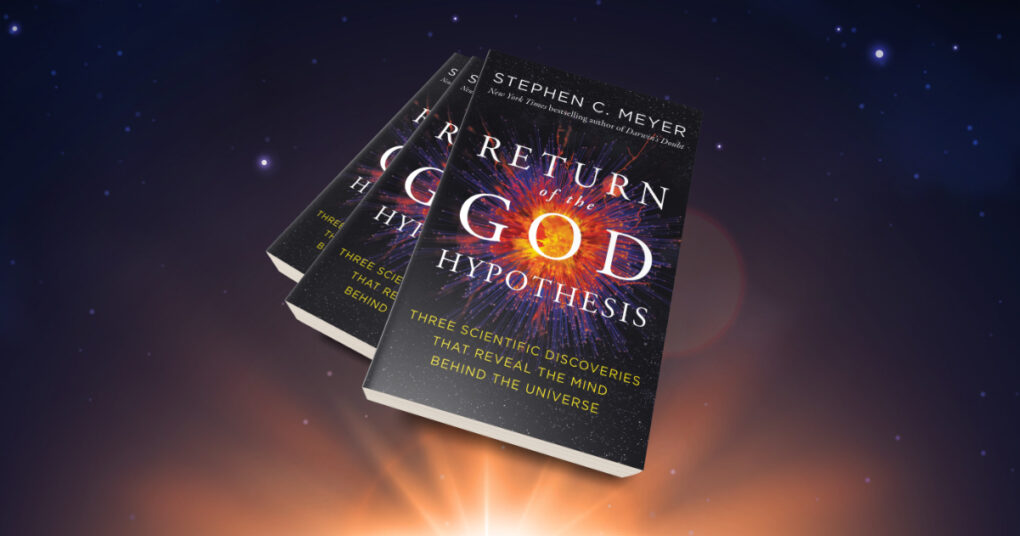Return of the God Hypothesis: Three Scientific Discoveries That Reveal the Mind Behind the Universe
Stephen C. Meyer
HarperOne
March 2021
576 pages
ISBN: 978-0062071507
Stephen C. Meyer is a well-known philosopher of science who, prior to The Return of the God Hypothesis (2021), published two notable works: Signature in the Cell (2009) and Darwin’s Doubt (2013). He is widely recognized as an exponent of intelligent design theory, which often faces significant mockery from dismissive scientists. Even on his Wikipedia page, he is described in disparaging terms, labeled as an advocate of pseudoscience. However, when you read through his extensive work – well over 500 pages – in The Return of the God Hypothesis, you come to the conclusion that this is serious science indeed.
At over 500 pages of fairly dense (for the layman like me) science this book is certainly not one to be read on the beach. In fact I must confessed that I began by listening to the audio version of this book which was frankly much too ambitious. The content of this book is not the kind that can be assimilated while making your bed. I had to start over again, this time with the ‘real’ book in one hand and a pencil in the other.
One thing that I have studied before is the question of the rise of science in the Christian West, and I found Meyer’s three opening chapters of this book to be an excellent survey of the matter. Here he examines the rise and fall of theistic science, providing a useful summary of the origins of science within the Judeo-Christian tradition. He begins with Greeks and medieval thinkers – who held a strong sense of the contingent nature of the world. The Judeo-Christian conviction that nature is intelligible was a crucial element in the development of science far beyond what the Classical world was ever able to achieve; without the intelligible and contingent nature of the world as revealed most fully in Christianity, science would simply not have been possible. Unlike many authors he acknowledges that Western science is an offspring of the Christian worldview, especially as understood by Medieval thinkers such as Robert Grosseteste who prepared the ground for the greats figures such as Isaac Newton of the scientific revolution in the seventeenth century.
However the theistic underpinnings of science were gradually dimmed from the Enlightenment onwards, giving way to scientific materialism leading to a situation where, By the beginning of the twentieth century, science – despite its theistic beginnings – seemed to have no need of the ‘God hypothesis.’ This leaves us where we are at the start of the twenty-first century: science and religion are often presented as implacable enemies, with science claiming a monopoly on rationality. Religious or spiritual explanations for creation generally dismissed as superstitious, irrational, or even devious. Religion is frequently portrayed as extrascience or pseudoscience. This concludes part one – a fascinating and useful synopsis of the development of science and its turn away from God and the divine role in the universe.
In the second part of the book Meyer addresses the root causes of a shift back towards the ‘God hypothesis’. He provides a complex explanation of scientific developments over the last three centuries, showing how science has come to recognize the universe as far more intricate than previously imagined. Rather than increasingly disproving God’s involvement, science seems to point more and more toward the need for a divine explanation for many inexplicable and marvelous phenomena.
These findings boil down to the following three: firstly, the discovery (a fascinating history in its own right) that the universe is not a static (and therefore eternal) universe, but rather one that had what appears to have been a starting point (the ‘Big Bang’). Secondly, the discoveries by cosmologists throughout the twentieth century of the utterly mind-boggling numbers around the ‘fine tuning’ of the universe, showing pretty conclusively to my mind, that the laws of nature are the work of a designer not of random chance. (However it is striking that ‘impossibility’ is a philosophical, not scientific concept. Scientists seem never to able to go beyond the realm of improbilities, even when they are so large that really mean ‘impossible’). And thirdly, the investigations by biologists from the 1950s onwards into the properties of DNA which reveal that DNA contains such vast amounts of complex information (about every last little dimension of life) that a conscious, intelligent, communicating source – which we call God – is the only possible explanation.
In the final section of the book Meyer looks closely at the attempts of scientists to come up with ‘naturalistic’ explanations of these phenomena, and here the book becomes particularly hard-going. In part this is because many of the theories arrived at to conjure up a naturalistic explanation for creation, the laws of physics and the phenomenon of life are so far-fetched. Nevertheless Meyer shows pretty convincingly that they fail miserably. In some cases, such as hypotheses regarding ‘multiverses’ simply try to resolve these questions by retreating into the realm of science-fiction fantasy. One gets the impression that scientists of an atheist bent are clutching at straws in order to defend their prior commitment to materialism.
There is another, more complicated, debate happening among theistic cosmologists as to whether one can strictly speaking ‘deduce’ the existence of God from the kind of scientific phenomena that Meyer looks at here, rather than through a specifically philosophical argument. It may be that Meyer blurs the boundaries between science and philosophy proper. Nevertheless this is a tremendous work, and one I’m sure that scientists in particular would find fascinating.
About the Author: Rev. Gavan Jennings
Rev. Gavan Jennings is a priest of the Opus Dei Prelature. He studied philosophy at University College Dublin, Ireland and the Pontifical University of the Holy Cross, Rome and is currently the editor of Position Papers.

